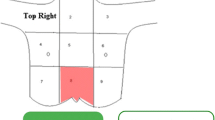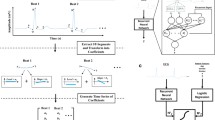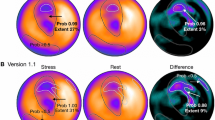Abstract
Despite uncertain yield, guidelines endorse routine stress myocardial perfusion imaging (MPI) for patients with suspected acute coronary syndromes, unremarkable serial electrocardiograms, and negative troponin measurements. In these patients, outcome prediction and risk stratification models could spare unnecessary testing. This study therefore investigated the use of artificial neural networks (ANN) to improve risk stratification and prediction of MPI and angiographic results. We retrospectively identified 5354 consecutive patients referred from the emergency department for rest-stress MPI after serial negative troponins and normal ECGs. Patients were risk stratified according to thrombolysis in myocardial infarction (TIMI) scores, ischemia was defined as >5 % reversible perfusion defect, and obstructive coronary artery disease was defined as >50 % angiographic obstruction. For ANN, the network architecture employed a systematic method where the number of neurons is changed incrementally, and bootstrapping was performed to evaluate the accuracy of the models. Compared to TIMI scores, ANN models provided improved discriminatory power. With regards to MPI, an ANN model could reduce testing by 59 % and maintain a 96 % negative predictive value (NPV) for ruling out ischemia. Application of an ANN model could also avoid 73 % of invasive coronary angiograms while maintaining a 98 % NPV for detecting obstructive CAD. An online calculator for clinical use was created using these models. The ANN models improved risk stratification when compared to the TIMI score. Our calculator could also reduce downstream testing while maintaining an excellent NPV, though further study is needed before the calculator can be used clinically.




Similar content being viewed by others
References
CDC (2011) National Hospital Ambulatory Medical Care Survey: 2011 Emergency Department Summary Tables. United States Centers for Disease Control and Prevention National Health Care Surveys
Amsterdam EA, Kirk JD, Bluemke DA, Diercks D, Farkouh ME, Garvey JL, Kontos MC, McCord J, Miller TD, Morise A, Newby LK, Ruberg FL, Scordo KA, Thompson PD, American Heart Association Exercise CR, Prevention Committee of the Council on Clinical Cardiology CoCN, Interdisciplinary Council on Quality of C, Outcomes R (2010) Testing of low-risk patients presenting to the emergency department with chest pain: a scientific statement from the American Heart Association. Circulation 122(17):1756–1776. doi:10.1161/CIR.0b013e3181ec61df
Pope JH, Aufderheide TP, Ruthazer R, Woolard RH, Feldman JA, Beshansky JR, Griffith JL, Selker HP (2000) Missed diagnoses of acute cardiac ischemia in the emergency department. N Engl J Med 342(16):1163–1170. doi:10.1056/NEJM200004203421603
Collinson PO, Premachandram S, Hashemi K (2000) Prospective audit of incidence of prognostically important myocardial damage in patients discharged from emergency department. BMJ 320(7251):1702–1705
Vukmir RB (2004) Medical malpractice: managing the risk. Med Law 23(3):495–513
White AA, Wright SW, Blanco R, Lemonds B, Sisco J, Bledsoe S, Irwin C, Isenhour J, Pichert JW (2004) Cause-and-effect analysis of risk management files to assess patient care in the emergency department. Acad Emerg Med 11(10):1035–1041. doi:10.1197/j.aem.2004.04.012
Herren KR, Mackway-Jones K (2001) Emergency management of cardiac chest pain: a review. Emerg Med J EMJ 18(1):6–10
Hermann LK, Newman DH, Pleasant WA, Rojanasarntikul D, Lakoff D, Goldberg SA, Duvall WL, Henzlova MJ (2013) Yield of routine provocative cardiac testing among patients in an emergency department-based chest pain unit. JAMA Intern Med 173(12):1128–1133. doi:10.1001/jamainternmed.2013.850
Cremer PC, Khalaf S, Agarwal S, Mayer-Sabik E, Ellis SG, Menon V, Cerqueira MD, Jaber WA (2014) Myocardial perfusion imaging in emergency department patients with negative cardiac biomarkers: yield for detecting ischemia, short-term events, and impact of downstream revascularization on mortality. Circ Cardiovasc Imaging 7(6):912–919. doi:10.1161/CIRCIMAGING.114.002401
Foy AJ, Liu G, Davidson WR, Sciamanna C, Leslie DL (2015) Comparative effectiveness of diagnostic testing strategies in emergency department patients with chest pain: an analysis of downstream testing, interventions, and outcomes. JAMA Intern Med 175(3):428–436. doi:10.1001/jamainternmed.2014.7657
Antman EM, Cohen M, Bernink PJ, McCabe CH, Horacek T, Papuchis G, Mautner B, Corbalan R, Radley D, Braunwald E (2000) The TIMI risk score for unstable angina/non-ST elevation MI: a method for prognostication and therapeutic decision making. JAMA 284(7):835–842
Pollack CV Jr, Sites FD, Shofer FS, Sease KL, Hollander JE (2006) Application of the TIMI risk score for unstable angina and non-ST elevation acute coronary syndrome to an unselected emergency department chest pain population. Acad Emerg Med 13(1):13–18. doi:10.1197/j.aem.2005.06.031
Freeman RV, Eagle KA, Bates ER, Werns SW, Kline-Rogers E, Karavite D, Moscucci M (2000) Comparison of artificial neural networks with logistic regression in prediction of in-hospital death after percutaneous transluminal coronary angioplasty. Am Heart J 140(3):511–520. doi:10.1067/mhj.2000.109223
Purwanto Eswaran C, Logeswaran R, Abdul Rahman AR (2012) Prediction models for early risk detection of cardiovascular event. J Med Syst 36(2):521–531
Hagan MT, Demuth HB, Beale MH (1996) Neural network design, 1st edn. PWS Publishing Co, Boston
Scales LE (1985) Introduction to non-linear optimization, 1st edn. City & Guilds, MacMillan
Clopper C, Pearson E (1934) The use of confidence or fiducial limits illustrated in the case of the binomial. Biometrika 26(4):404–413. doi:10.1093/biomet/26.4.404
Blakeley DD, Oddone EZ, Hasselblad V, Simel DL, Matchar DB (1995) Noninvasive carotid artery testing. A meta-analytic review. Ann Intern Med 122(5):360–367
Altman DG, Bland JM (1994) Diagnostic tests 2: predictive values. BMJ 309(6947):102
Isma’eel HA, Sakr GE, Habib RH, Almedawar MM, Zgheib NK, Elhajj IH (2014) Improved accuracy of anticoagulant dose prediction using a pharmacogenetic and artificial neural network-based method. Eur J Clin Pharmacol 70(3):265–273. doi:10.1007/s00228-013-1617-2
Harrison RF, Kennedy RL (2005) Artificial neural network models for prediction of acute coronary syndromes using clinical data from the time of presentation. Ann Emerg Med 46(5):431–439. doi:10.1016/j.annemergmed.2004.09.012
Baxt WG, Skora J (1996) Prospective validation of artificial neural network trained to identify acute myocardial infarction. Lancet 347(8993):12–15
Nawar EW, Niska RW, Xu J (2007) National Hospital ambulatory medical care survey: 2005 emergency department summary. Adv Data 386:1–32
Pitts SR, Niska RW, Xu J, Burt CW (2008) National hospital ambulatory medical care survey: 2006 emergency department summary. Natl Health Stat Rep 7:1–38
Lee TH, Goldman L (2000) Evaluation of the patient with acute chest pain. N Engl J Med 342(16):1187–1195. doi:10.1056/NEJM200004203421607
deFilippi CR, Rosanio S, Tocchi M, Parmar RJ, Potter MA, Uretsky BF, Runge MS (2001) Randomized comparison of a strategy of predischarge coronary angiography versus exercise testing in low-risk patients in a chest pain unit: in-hospital and long-term outcomes. J Am Coll Cardiol 37(8):2042–2049
Than M, Flaws D, Sanders S, Doust J, Glasziou P, Kline J et al (2014) Development and validation of the emergency department assessment of chest pain score and 2 h accelerated diagnostic protocol. Emerg Med Aust 26:34–44. doi:10.1111/1742-6723.12164
Backus BE, Six AJ, Kelder JC, Bosschaert MAR, Mast EG, Mosterd A et al (2013) A prospective validation of the HEART score for chest pain patients at the emergency department. Int J Cardiol 1688:2153–2158
Udelson JE, Beshansky JR, Ballin DS, Feldman JA, Griffith JL, Handler J, Heller GV, Hendel RC, Pope JH, Ruthazer R, Spiegler EJ, Woolard RH, Selker HP (2002) Myocardial perfusion imaging for evaluation and triage of patients with suspected acute cardiac ischemia: a randomized controlled trial. JAMA 288(21):2693–2700
Gomez MA, Anderson JL, Karagounis LA, Muhlestein JB, Mooers FB (1996) An emergency department-based protocol for rapidly ruling out myocardial ischemia reduces hospital time and expense: results of a randomized study (ROMIO). J Am Coll Cardiol 28(1):25–33
Farkouh ME, Smars PA, Reeder GS, Zinsmeister AR, Evans RW, Meloy TD, Kopecky SL, Allen M, Allison TG, Gibbons RJ, Gabriel SE (1998) A clinical trial of a chest-pain observation unit for patients with unstable angina. Chest pain evaluation in the emergency room (CHEER) investigators. N Engl J Med 339(26):1882–1888. doi:10.1056/NEJM199812243392603
Author information
Authors and Affiliations
Corresponding authors
Ethics declarations
Conflict of interest
Author Isma’eel HA declares that he has no conflict of interest. Author Cremer PC declares that he has no conflict of interest. Author Khalaf S declares that she has no conflict of interest. Author Almedawar MM declares that he has no conflict of interest. Author Elhajj IH declares that he has no conflict of interest. Author Sakr GE declares that he has no conflict of interest. Author Jaber WA declares that he has no conflict of interest.
Ethical approval
All procedures performed in studies involving human participants were in accordance with the ethical standards of the institutional and/or national research committee and with the 1964 Helsinki declaration and its later amendments or comparable ethical standards.
Informed consent
Informed consent was obtained from all individual participants included in the study.
Additional information
Hussain A. Isma’eel and Paul C. Cremer are co-authors with equal contribution.
Rights and permissions
About this article
Cite this article
Isma’eel, H.A., Cremer, P.C., Khalaf, S. et al. Artificial neural network modeling enhances risk stratification and can reduce downstream testing for patients with suspected acute coronary syndromes, negative cardiac biomarkers, and normal ECGs. Int J Cardiovasc Imaging 32, 687–696 (2016). https://doi.org/10.1007/s10554-015-0821-9
Received:
Accepted:
Published:
Issue Date:
DOI: https://doi.org/10.1007/s10554-015-0821-9




